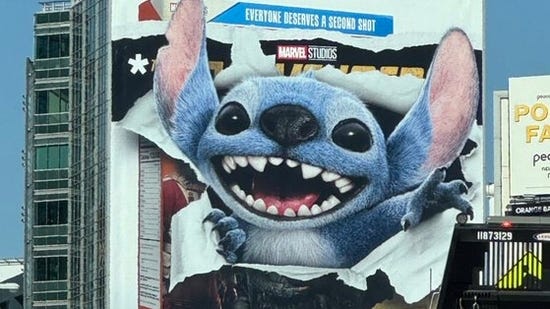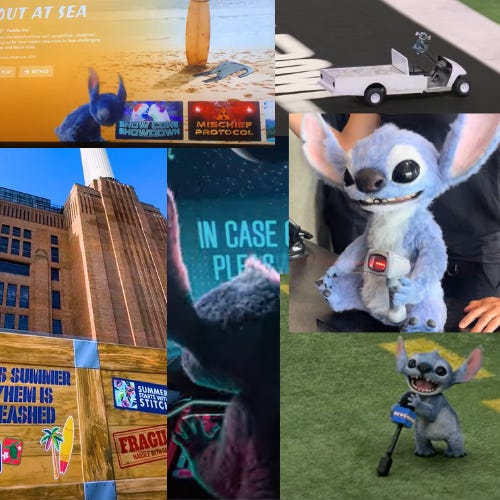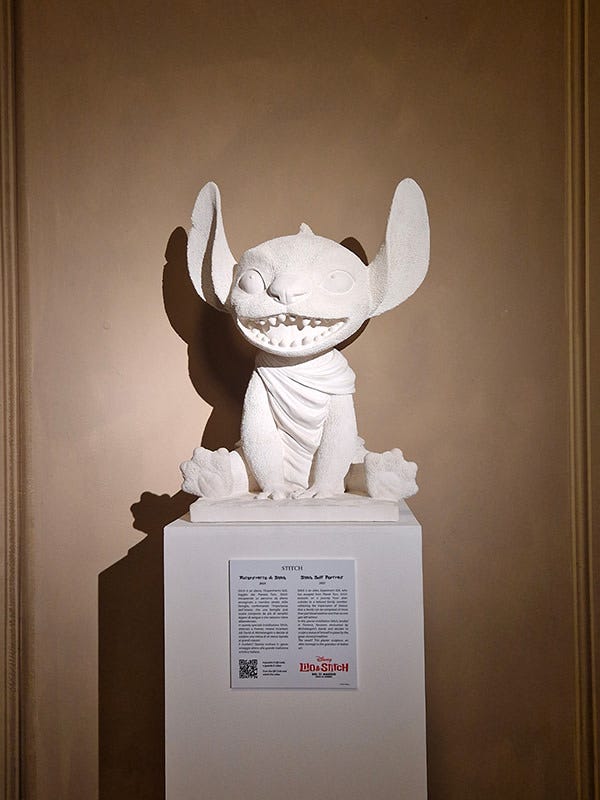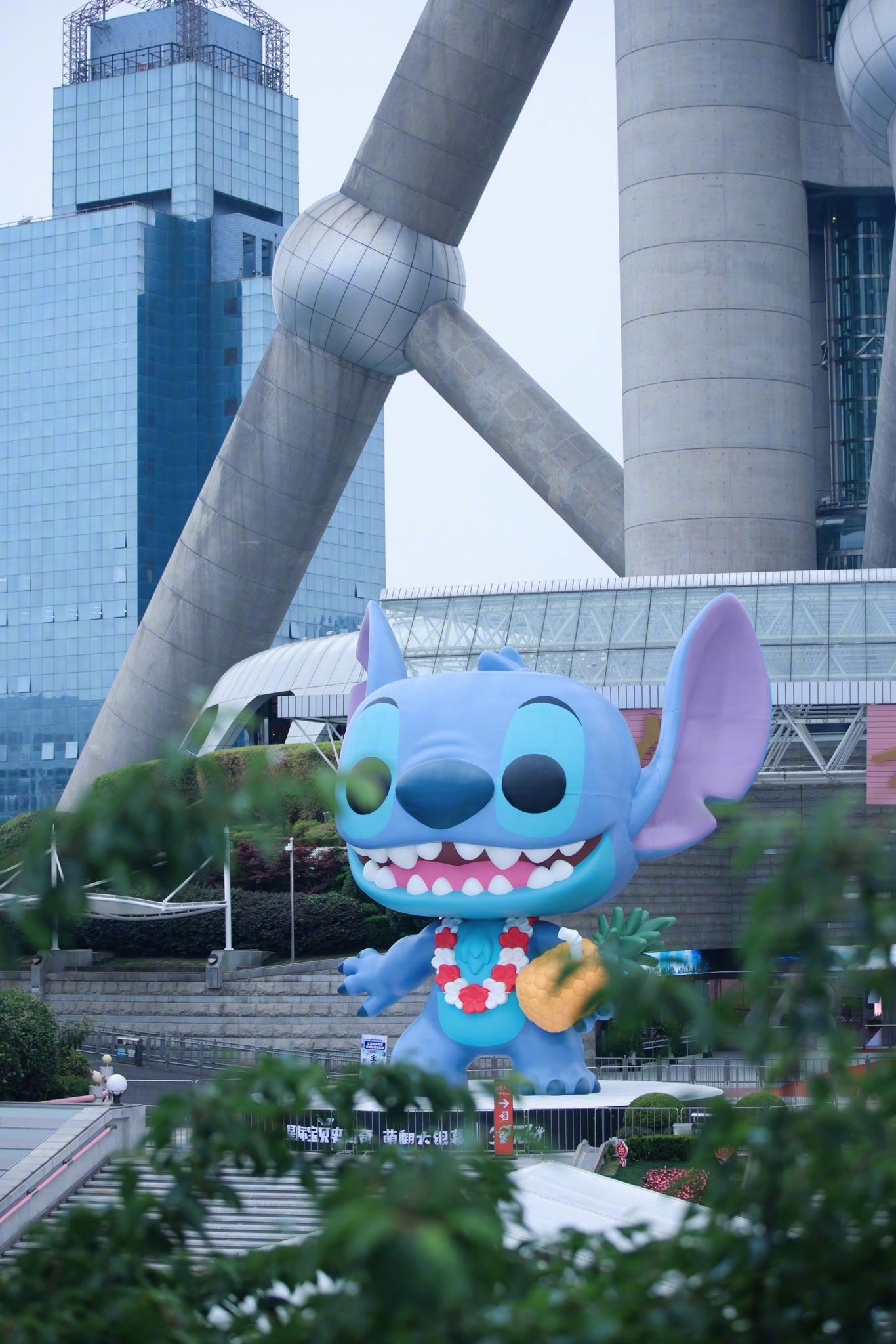There are a lot of movies dropping this summer.
Like, a lot.
But one campaign keeps pulling me back in—and not because it’s the biggest, or even the flashiest. It’s because it’s weirdly smart.
It’s the one that has that little blue alien-dog-looking-thing and his tiny Hawaiian human in it—you know the one right?
That’s right—Lilo & Stitch (and no, Lilo’s not the alien).
🌺 A FAMILY THAT FINDS YOU
Stitch was never meant to last.
He’s small. Weird. Loud. Chaotic. A failed experiment exiled to a remote planet (one called E-ARTH). He's not even the main character in his own film — not really. Lilo & Stitch is about Lilo: a lonely Hawaiian girl learning to live again after grief. It’s her story. Stitch just… crashes into it.
But that’s exactly what makes him powerful. He’s a disruptor. A wildcard. He breaks things so they can be remade. Family. Identity. Belonging.
That idea — that family can find you, even when you're broken — resonates harder than ever in 2025. Amid chaos and cultural splintering, Stitch represents something rare:
Hope with sharp teeth.
This emotional core is what Disney has latched onto and amplified across every channel. The message isn’t subtle — it’s repeated through copy, visual language, and community engagement. And it’s working.
Even my experience watching it this weekend echoed this. You see, I saw the film with my girlfriend, and she was bawling her eyes out for most of the film—it nearly had me I must say.
I don’t say that lightly either you know.
The film really did have me in my feels, and that really was surprising because I didn’t remember the original one having me like that (it’s been a while—maybe it did).
It wasn’t just nostalgic. It was relieving. The room felt it.
Just like everyone else did — Lilo & Stitch received an “A” from CinemaScore, a rare badge of genuine audience satisfaction. This wasn’t just a film. It was a feeling.
💣 STITCH VS. THE SYSTEM
This kind of emotional resonance isn’t accidental. It’s engineered — not in a cynical way, but in the way Disney builds worlds. And if you want to understand what’s happening here, you have to look at how Disney launched this thing.
They didn’t market Lilo & Stitch like a kids’ movie.
They marketed it like a cultural outbreak.
And its worked, Let’s talk numbers…
$183 million over Memorial Day Weekend — breaking the record set by Top Gun: Maverick
Second-biggest four-day opening of all time, just behind Black Panther
$341.7M global opening, on a $200M budget
And this one’s wild: It outperformed Snow White’s entire global run in just four days
This isn’t just success — it’s systemic domination. A blue alien in a legacy reboot just punked two major IPs (Top Gun and Snow White) and positioned himself as the heart of Disney’s summer slate.
And that was just the beginning.
🌐 Stitch Is Everywhere—and That’s the Whole Point
If the screen is the spark, then the street is the wildfire.
Stitch didn’t just show up in ads. He showed up everywhere.
From popping up in cinemas, crashing TV screens, infiltrating sports games, to literally bursting through billboards. Stitch is deliberately being put in places he doesn’t belong, to create noise and show off how chaotic he is. Stitch has been the chaos you can’t avoid.
So, it’s safe to say Disney has been pushing Stitch hard!
And at first glance, it might just look like Disney is being Disney—you know…
Big character, big push, lots of media budget.
But like I said, this is more deliberate than that. The placements are noisy, and they’re smartly chaotic, because you’ve got placements like:
This Hulu pre-roll ad, where Stitch straight up hijacks the ad.
A Regal rollercoaster takeover that turns the cinema short clip into a Stitch scene.
Live animatronic activations where he scans your tickets.
A giant crate dropped into Battersea Power Station, which Stitch supposedly escaped from.
And of course, the Super Bowl Spot, where Stitch causes chaos on the pitch!
You’ve also got these 3 amazing activations that bring Stitch into the real world at scale:
In Florence, Disney staged one of its boldest activations yet.
They collaborated with the Galleria dell’Accademia (home of Michelangelo’s David) and the Italian Ministry of Culture to create a campaign that merged high art with cartoon mayhem. The result: a promotional video where David and Stitch face off, bringing younger generations “closer to art through inclusive language.”
→ Now, you probably didn’t think these 2 things would come together, seeing as they’re pretty contrasting. However, I think it’s smart and it means well—while some people on the internet do disagree with that sentiment—the activation in itself shows the reach Disney has and the impact it has on culture. With the activation aiming to do more than simply promote a film, but instead use a modern IP to encourage younger audiences to explore history and the masterpieces that come with it.
In Shanghai, a 25-foot Stitch Funko statue appeared outside a major shopping district.
He’s standing, grinning, towering over the skyline like a kawaii kaiju. Around him? A branded Stitch pop-up and character experiences that flood Chinese social media.
And of course — Disney’s own castles weren’t safe either.
In a nod to the original Lilo & Stitch promos, Stitch toilet-papered Cinderella’s castle again — this time, digitally. Mischief as legacy.
But, what ties it all together is this: Disney’s not just reminding us that Stitch exists—they’re making it feel like he’s here. In the real world.
That’s not just nostalgia. That’s immersion. That’s brand universe work disguised as hijinks.
🔌 So, What’s the Strategy?
From where I’m sitting, this campaign breaks down into three big plays:
1. Stature
Mass reach, iconic placements, and heavy awareness tactics. The Super Bowl & Sunset Blvd billboard takeovers—these aren’t niche. These are “we want you to see this whether you care or not” plays.

2. Immersion & Human Moments
This is where it gets clever. Stitch is being treated like a real character with real world impact. Animatronics, crates, even weird donut collabs—it all builds a sense of Stitch as a presence, not a promo.
3. Co-viewing Plays
You can tell Disney’s targeting families, but in a way that’s meant to feel funny to parents and magical to kids. They’re leaning into that chaotic Stitch energy without losing the sweetness of the original film, and creating shared moments that appeal to both kids and adults (remember: parents hold the wallets).
These kinds of activations don’t just sell tickets—they sell emotion and turn a film into a moment. All in all, it’s smart. Especially when you consider what other competing IPs are gunning for the big screen this year…
‼️ The Stitch Strategy Is Also a Statement
Here’s the part that really gets me.
This isn’t just about selling tickets for a Lilo & Stitch remake. It feels like Disney is trying to set a tone—for their summer. Almost like Stitch is the unofficial mascot for everything they’ve got coming: Fantastic Four, Elio, maybe even some deeper IP surprises.
With Fantastic Four and Elio also on the way, Stitch is acting as a kind of kickoff—a mascot of sorts for “Disney’s Summer.” These big OOH activations are engineered to create UGC moments and drive earned media—making those expensive investments (like the Super Bowl or the Battersea crate, widely different minimum spends I’m sure) work harder by being meme-worthy, emotional, and unforgettable.
This whole campaign is soft power. It’s emotional association. It’s “own the cultural tone before someone else does.”
And honestly? It’s working.
🗓️ Dissecting the Media Plan
From a media planning lens, this campaign will of course be omni-channel, global, and built on channel synergy. If I were building it, I’d break it into three main pillars:
1. Digital-First
This is where scale and spend live. Social (TikTok, Instagram, Snapchat filters, etc), AV (YouTube, VOD, Amazon), and digital display formats across high-traffic sites. These channels do heavy lifting for awareness and quick recall—they will also benefit the actual sell, driving easy journeys for the user to convert.
2. Traditional with a Twist
Cinema (naturally), TV spots, and OOH (Out-Of-Home) are key—but they’re elevated through tech or experience. Think: 3D billboards, AR layers, themed placements. Even experiential layers like the Stitch animatronic at D23 blur the line between ad and activation.
3. Tactical & Cultural Hacks - the fun PR stuff
This is where Disney gets clever. Stitch crashing movie posters. The Krispy Kreme tie-in. These feel like PR stunts, but they’re just good tactical planning—maximising cultural resonance and earned media in one shot.
♾️ Brand Universe Moves
If we zoom out into brand universe strategy, this campaign feels like Disney seeding a bigger comeback for Stitch—and setting the tone for other remakes to come.
Here’s what might be next:
Gaming activations – Fortnite skins or Roblox integrations to pull younger audiences in.
Merchandising momentum – We’ve already seen collectibles, cinema exclusives, and even a custom Labubu (concept), which is a smart nod to fashion/streetwear hype cycles.
Franchise flywheel – This could be Disney’s way of testing appetite for a Stitch Universe reboot. Sequels, series spin-offs, or even limited releases of retro media. It’s not just nostalgia—it’s IP expansion disguised as a movie.
If this hits big (and it has been so far), don’t be surprised if a Stitch+ universe starts to quietly grow.
🎥 Looking Back to Look Forward
Interestingly, the OG Lilo & Stitch film from 2002 was also a disruptive marketing moment for Disney. At the time, it flipped the script by:
Infiltrating other Disney films (e.g., Lion King, Aladdin) with parody trailers.
Creating tension with the rise of DreamWorks’ cheeky tone (with Shrek).
Positioning Stitch as a wildcard in the Disney line-up (a great one at that).
And fun fact: The Memorial Day weekend marked a rematch of sorts—Stitch vs. Tom Cruise again, just like in 2002 & we now know how that went!
Disney has always known that story is stronger than slogan. But with Stitch, they’re showing how a character can become the campaign.
In-character marketing.
Stitch gave full-blown interviews to IGN, Rotten Tomatoes and more — in character. He joked about not being a homewrecker when asked about taking Princess Jasmine away from Aladdin. He told us he wants to be Iron Stitch. He answered fans directly. He hijacked Disney’s Instagram grid with chaotic selfies and pop-culture references. Stitch, the character, was doing PR — not the actors. That’s rare. And it’s genius.
→ Looking back, I barely scratched the surface of in-character marketing when I wrote about how Venom 3 used this. Although they have very different tones, I think you’d agree that Lilo & Stitch adopting this strategy feels much more fluid and ultimately right. And, that’s because this time it didn’t feel like a gimmick and out of place, instead it felt more like we were a part of the conversation and Stitch was actually attainable.
To amplify this even further, I wonder whether smaller creators could get involved in this type of activity. That way more user-generated content can be generated, and the character can takeover more areas of the internet & ultimately reach more audiences!
This isn’t just a movie campaign. It’s a brand taking form — physically, digitally, emotionally — through character. It’s like Stitch said, it was only "a publicity stunt”—when he took Jasmine away from Aladdin—meaning, he was a part of the plan, and acknowledged that, which means fictional PR exists—the question now is, how far can we take this?
🧠 STITCH ISN’T JUST A THROWBACK. HE’S A BLUEPRINT.
When you zoom out, what Disney has done with Lilo & Stitch isn’t just revive a classic. They’ve gone and laid a foundation for how stories can live beyond their medium.
Through omnichannel immersion. Through emotional resonance. Through physical activations. Through world-building.
Stitch hijacked the system. And for anyone watching — creators, strategists, marketers — the lesson is clear:
Make something people feel.
Make them cry, laugh, buy, share, wear.
Make them want to follow your story across time and touchpoints.
Because then, it’s not just a story.
🔹 It’s a system.
🔹 It’s a universe.
🔹 And it’s family.
🤔 Final Thought
This campaign isn’t just good. It’s strategically joyful. It’s using character chaos to unify an ecosystem—merch, fandom, nostalgia, summer hype—and remind people why Disney’s emotional storytelling still matters in a fractured content world.
I really hope you enjoyed this breakdown & learnt something new you can use in your campaigns, work, or discussions!
Striving for perfectionism, always,
Dan










